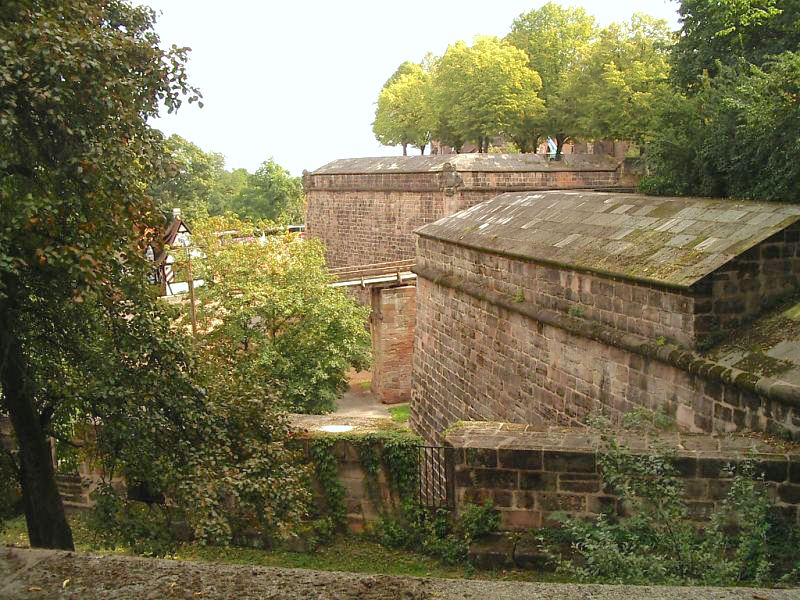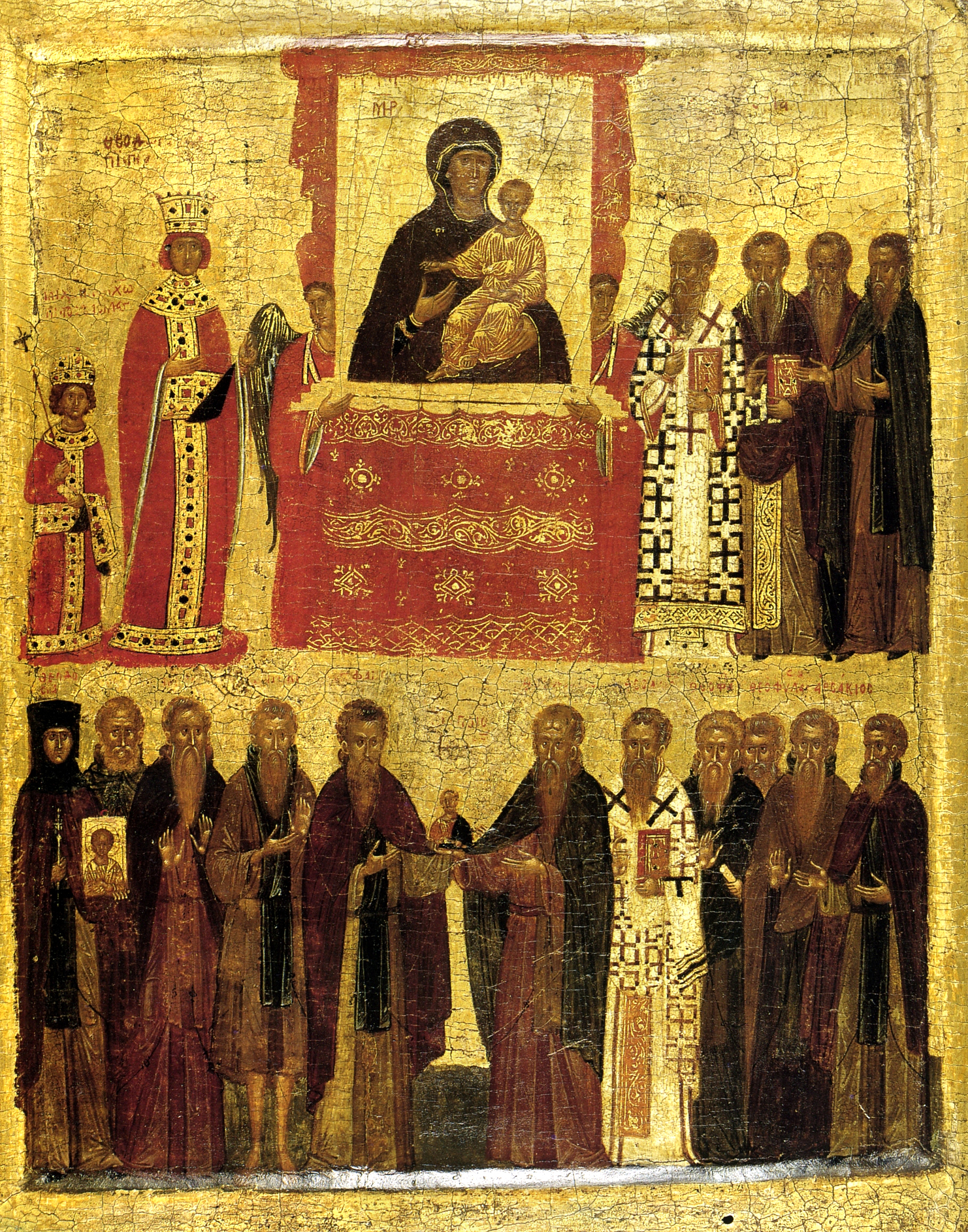|
Angelic Salutation (Stoss)
''Angelic Salutation'' (German: ''Engelsgruß'') is an assemblage of life-sized limewood sculptures celebrating the Annunciation by the late-Gothic German artist Veit Stoss. It was commissioned in 1517 by Anton II Tucher and completed the following year. Tucher was a high ranking official in Nuremberg in southern Germany, and donated the work to the medieval church of St. Lorenz (or St. Lawrence) in Nuremberg, where it still freely suspended on a metal chain in the center of the choir, facing the high altar.Burkhard (1935), p. 37 Description The sculptures are dominated by the life-sized figures of Virgin Mary and Archangel Gabriel, from whom the work takes its name.Burkhard (1935), p. 35 They are suspended within a circular frame resembling a wreath of roses, that represent the rosary of the Annunciation. ''Angelic Salutation is widely regarded as Stoss' masterpiece.Burkhard (1935), p. 31 Mary and Gabriel are surrounded by a series of small angels, many of whom are ringing be ... [...More Info...] [...Related Items...] OR: [Wikipedia] [Google] [Baidu] |
Nürnberg St Lorenz Veit Stoß Engelsgruß
Nuremberg ( ; german: link=no, Nürnberg ; in the local East Franconian dialect: ''Nämberch'' ) is the second-largest city of the Germany, German States of Germany, state of Bavaria after its capital Munich, and its 518,370 (2019) inhabitants make it the List of cities in Germany by population, 14th-largest city in Germany. On the Pegnitz (river), Pegnitz River (from its confluence with the Rednitz in Fürth onwards: Regnitz, a tributary of the Main (river), River Main) and the Rhine–Main–Danube Canal, it lies in the Bavarian Regierungsbezirk, administrative region of Middle Franconia, and is the largest city and the unofficial capital of Franconia. Nuremberg forms with the neighbouring cities of Fürth, Erlangen and Schwabach a continuous conurbation with a total population of 800,376 (2019), which is the heart of the urban area region with around 1.4 million inhabitants, while the larger Nuremberg Metropolitan Region has approximately 3.6 million inhabitants. The city ... [...More Info...] [...Related Items...] OR: [Wikipedia] [Google] [Baidu] |
Rosary
The Rosary (; la, , in the sense of "crown of roses" or "garland of roses"), also known as the Dominican Rosary, or simply the Rosary, refers to a set of prayers used primarily in the Catholic Church, and to the physical string of knots or beads used to count the component prayers. When referring to the prayer, the word is usually capitalized ("the Rosary", as is customary for other names of prayers, such as "the Lord's Prayer", and "the Hail Mary"); when referring to the prayer beads as an object, it is written with a lower-case initial letter (e.g. "a rosary bead"). The prayers that compose the Rosary are arranged in sets of ten Hail Marys, called "decades". Each decade is preceded by one Lord's Prayer ("Our Father"), and traditionally followed by one Glory Be. Some Catholics also recite the " O my Jesus" prayer after the Glory Be; it is the most well-known of the seven Fátima prayers that appeared in the early 20th century. Rosary prayer beads are an aid for saying ... [...More Info...] [...Related Items...] OR: [Wikipedia] [Google] [Baidu] |
Sculptures Of The Annunciation
Sculpture is the branch of the visual arts that operates in three dimensions. Sculpture is the three-dimensional art work which is physically presented in the dimensions of height, width and depth. It is one of the plastic arts. Durable sculptural processes originally used carving (the removal of material) and modelling (the addition of material, as clay), in stone, metal, ceramic art, ceramics, wood and other materials but, since Modernism, there has been an almost complete freedom of materials and process. A wide variety of materials may be worked by removal such as carving, assembled by welding or modelling, or Molding (process), moulded or Casting, cast. Sculpture in stone survives far better than works of art in perishable materials, and often represents the majority of the surviving works (other than pottery) from ancient cultures, though conversely traditions of sculpture in wood may have vanished almost entirely. However, most ancient sculpture was brightly painted, ... [...More Info...] [...Related Items...] OR: [Wikipedia] [Google] [Baidu] |
Jeffrey Chipps Smith
Jeffrey Chipps Smith is an American art historian specialising in the Northern Renaissance and Baroque art and architecture. He has published a number of prize winning books on art history. In 2005 he wrote the introduction for a reprint of Erwin Panofsky's classic "The Life and Art of Albrecht Dürer". He is an inaugural co-editor of the '' Journal of the Historians of Netherlandish Art''. . ''Journal of Historians of Netherlandish Art'', v. 3:2, Summer 2011. Retrieved 17 March 2012. Publications * ''New Perspectives on the Art of Renaissance Nuremberg: Five Essays''. Austin, 1985 * ''German Sculpture of the Later Renaissance, c. 1520-1580: Art in an Age of Uncertainty''. Princeton, 1994 * ''Sensuous Worship: Jesuits and the Art of the Early Catholic Reformation in Germany''. Princeton, 2002 * ''The Northern Renaissance''. Lond ...[...More Info...] [...Related Items...] OR: [Wikipedia] [Google] [Baidu] |
Susie Nash
Susie Nash is the Deborah Loeb Brice Professor of Renaissance Art at the Courtauld Institute, London. After studying at the University of Reading (BA 1986, PhD 1993) she has been at the Courtauld. She is an expert on the art of the Northern Renaissance, specialising in Early Netherlandish painting and illuminated manuscripts and 15th century sculpture. Professor Nash is known for her work on the Chartreuse de Champmol in Dijon, and in particular the Great Cross, or Well of Moses, by Claus Sluter and Jean Malouel, published in a series of three articles in the Burlington Magazine.Nash, S., ‘Claus Sluter’s Well of Moses for the Chartreuse de Champmol reconsidered,’ Parts I, II and III, The Burlington Magazine, vol 147 (2005), pp. 798-809; vol. 148 (2006), pp. 456-467; vol. 150 (2008), pp. 724-741 She is a founder member of the Research Centre for Illuminated Manuscripts and the Courtauld Sculptural Processes Study Group, and a Trustee of thCaroline Villers Research Fellowship S ... [...More Info...] [...Related Items...] OR: [Wikipedia] [Google] [Baidu] |
Andreas Osiander
Andreas Osiander (; 19 December 1498 – 17 October 1552) was a German Lutheran theologian and Protestant reformer. Career Born at Gunzenhausen, Ansbach, in the region of Franconia, Osiander studied at the University of Ingolstadt before being ordained as a priest in 1520 in Nuremberg. In the same year he began work at an Augustinian convent in Nuremberg as a Hebrew tutor. In 1522, he was appointed to the church of St. Lorenz in Nuremberg, and at the same time publicly declared himself to be a Lutheran. During the First Diet of Nuremberg (1522), he met Albert of Prussia, Grand Master of the Teutonic Knights, and played an important role in converting him to Lutheranism. He also played a prominent role in the debate which led to the city of Nuremberg's adoption of the Reformation in 1525, and in the same year Osiander married. Osiander attended the Marburg Colloquy (1529), the Diet of Augsburg (1530) and the signing of the Schmalkalden articles (1531). The Augsburg I ... [...More Info...] [...Related Items...] OR: [Wikipedia] [Google] [Baidu] |
Holy Day Of Obligation
In the Catholic Church, holy days of obligation are days on which the faithful are expected to attend Mass, and engage in rest from work and recreation (id est, they are to refrain from engaging in work or activities that hinder the worship owed to God), according to the third Commandment. The expectation is attached to the holy day, even if transferred to another date, as sometimes happens in the Roman Rite. However, in some countries a dispensation is granted in such circumstances. Latin Church The holy days of obligation for Latin Church Catholics are indicated in canon 1246 of the 1983 Code of Canon Law: Placed in the order of the liturgical calendar, the ten days (apart from Sundays) that this canon mentions are: *8 December: Solemnity of the Immaculate Conception of the Blessed Virgin Mary *25 December: Solemnity of the Nativity of the Lord (Christmas) *1 January: Solemnity of Mary, the Holy Mother of God *6 January: Solemnity of the Epiphany of the Lord *19 March: Sole ... [...More Info...] [...Related Items...] OR: [Wikipedia] [Google] [Baidu] |
Lutheranism
Lutheranism is one of the largest branches of Protestantism, identifying primarily with the theology of Martin Luther, the 16th-century German monk and Protestant Reformers, reformer whose efforts to reform the theology and practice of the Catholic Church launched the Reformation, Protestant Reformation. The reaction of the government and church authorities to the international spread of his writings, beginning with the ''Ninety-five Theses'', divided Western Christianity. During the Reformation, Lutheranism became the state religion of numerous states of northern Europe, especially in northern Germany, Scandinavia and the then-Livonian Order. Lutheran clergy became civil servants and the Lutheran churches became part of the state. The split between the Lutherans and the Roman Catholics was made public and clear with the 1521 Edict of Worms: the edicts of the Diet (assembly), Diet condemned Luther and officially banned citizens of the Holy Roman Empire from defending or propagatin ... [...More Info...] [...Related Items...] OR: [Wikipedia] [Google] [Baidu] |
Iconoclasm
Iconoclasm (from Ancient Greek, Greek: grc, wikt:εἰκών, εἰκών, lit=figure, icon, translit=eikṓn, label=none + grc, wikt:κλάω, κλάω, lit=to break, translit=kláō, label=none)From grc, wikt:εἰκών, εἰκών + wikt:κλάω, κλάω, lit=image-breaking. ''Iconoclasm'' may also be considered as a back-formation from ''iconoclast'' (Greek: εἰκοκλάστης). The corresponding Greek word for iconoclasm is εἰκονοκλασία, ''eikonoklasia''. is the social belief in the importance of the destruction of icons and other images or monuments, most frequently for religious or political reasons. People who engage in or support iconoclasm are called iconoclasts, a term that has come to be figuratively applied to any individual who challenges "cherished beliefs or venerated institutions on the grounds that they are erroneous or pernicious." Conversely, one who reveres or venerates religious images is called (by iconoclasts) an ''Iconolatry, ic ... [...More Info...] [...Related Items...] OR: [Wikipedia] [Google] [Baidu] |
Protestant Reformation
The Reformation (alternatively named the Protestant Reformation or the European Reformation) was a major movement within Western Christianity in 16th-century Europe that posed a religious and political challenge to the Catholic Church and in particular to papal authority, arising from what were perceived to be Criticism of the Catholic Church, errors, abuses, and discrepancies by the Catholic Church. The Reformation was the start of Protestantism and the split of the Western Church into Protestantism and what is now the Roman Catholic Church. It is also considered to be one of the events that signified the end of the Middle Ages and the beginning of the early modern period in Europe.Davies ''Europe'' pp. 291–293 Prior to Martin Luther, there were many Proto-Protestantism, earlier reform movements. Although the Reformation is usually considered to have started with the publication of the ''Ninety-five Theses'' by Martin Luther in 1517, he was not excommunicated by Pope Leo X ... [...More Info...] [...Related Items...] OR: [Wikipedia] [Google] [Baidu] |


.jpg)

.jpg)
